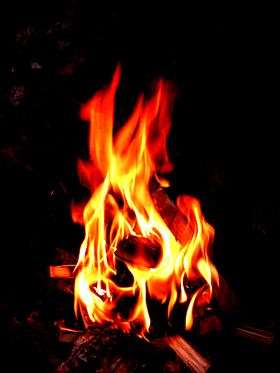Slash-and-burn
Slash-and-burn agriculture, also called fire-fallow cultivation,[1] is a farming method that involves the cutting and burning of plants in a forest or woodland to create a field called a swidden. The method begins by cutting down the trees and woody plants in an area. The downed vegetation, or "slash", is then left to dry, usually right before the rainiest part of the year. Then, the biomass is burned, resulting in a nutrient-rich layer of ash which makes the soil fertile, as well as temporarily eliminating weed and pest species. After about three to five years, the plot's productivity decreases due to depletion of nutrients along with weed and pest invasion, causing the farmers to abandon the field and move over to a new area. The time it takes for a swidden to recover depends on the location and can be as little as five years to more than twenty years, after which the plot can be slashed and burned again, repeating the cycle.[2][3][4] In India, the practice is known as jhum or jhoom.[5][6]
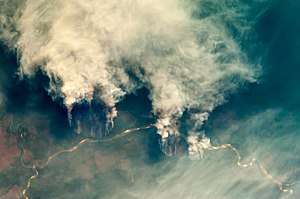
| Agriculture |
|---|
 |
|
Categories
|
|
|
Slash-and-burn can be part of shifting cultivation, an agricultural system in which farmers routinely move from one cultivable area to another. It may also be part of transhumance, the moving of livestock between seasons. A rough estimate is that 200 million to 500 million people worldwide use slash-and-burn.[2][7] In 2004, it was estimated that in Brazil alone, 500,000 small farmers each cleared an average of one hectare (2.47105 acres) of forest per year.[1] The technique is not scalable or sustainable for large human populations. Methods such as Inga alley cropping[8] and slash-and-char[9] have been proposed as alternatives which would cause less environmental degradation.[10]
A similar term is assarting, which is the clearing of forests, usually (but not always) for the purpose of agriculture. Assarting does not include burning.
History
Historically, slash-and-burn cultivation has been practiced throughout much of the world, in grasslands as well as woodlands.
During the Neolithic Revolution, which included agricultural advancements, groups of hunter-gatherers domesticated various plants and animals, permitting them to settle down and practice agriculture, which provides more nutrition per hectare than hunting and gathering. This happened in the river valleys of Egypt and Mesopotamia. Due to this decrease in food from hunting, as human populations increased, agriculture became more important. Some groups could easily plant their crops in open fields along river valleys, but others had forests blocking their farming land.
In this context, humans used slash-and-burn agriculture to clear more land to make it suitable for plants and animals. Thus, since Neolithic times, slash-and-burn techniques have been widely used for converting forests into crop fields and pasture.[11] Fire was used before the Neolithic as well, and by hunter-gatherers up to present times. Clearings created by the fire were made for many reasons, such as to draw game animals and to promote certain kinds of edible plants such as berries.
Slash-and-burn fields are typically used and owned by a family until the soil is exhausted. At this point the ownership rights are abandoned, the family clears a new field, and trees and shrubs are permitted to grow on the former field. After a few decades, another family or clan may then use the land and claim usufructuary rights. In such a system there is typically no market in farmland, so land is not bought or sold on the open market and land rights are traditional. In slash-and-burn agriculture, forests are typically cut months before a dry season. The "slash" is permitted to dry and then burned in the following dry season. The resulting ash fertilizes the soil[12][13] and the burned field is then planted at the beginning of the next rainy season with crops such as upland rice, maize, cassava, or other staples. Most of this work is typically done by hand, using such basic tools such as machetes, axes, hoes, and makeshift shovels. Old American civilizations, like the Inca, Maya and Aztecs, also used this agricultural technique. Sometimes, the flames spread and caused forest fires which would lead to loss of life (both wild animals and human beings).
Large families or clans wandering in the lush woodlands long continued to be the most common form of society through human prehistory. Axes to fell trees and sickles for harvesting grain were the only tools people might bring with them. All other tools were made from materials they found at the site, such as fire stakes of birch, long rods (Vanko), and harrows made of spruce tops. The extended family conquered the lush virgin forest, burned and cultivated their carefully selected swidden plots, sowed one or more crops, and then proceeded on to forests that had been noted in their wanderings. In the temperate zone, the forest regenerated in the course of a lifetime. So swidden was repeated several times in the same area over the years. But in the tropics the forest floor gradually depleted. It was not only in the moors, as in Northern Europe, but also in the steppe, Savannah, prairie, pampas and barren desert in tropical areas where shifting cultivation is the oldest type of farming. Cultivation is similar to slash-and-burn. (Clark 1952 91–107).[14]
In Sweden the practice is known as svedjebruk.
Historical references
Southern European Mediterranean climates have favored evergreen and deciduous forests. With slash-and-burn agriculture, this type of forest was less able to regenerate than those north of the Alps. Although in northern Europe one crop was usually harvested before grass was allowed to grow, in southern Europe it was more common to exhaust the soil by farming it for several years.
Classical authors mentioned large forests,[15] with Homer writing about "wooded Samothrace", Zakynthos, Sicily, and other woodlands.[16] These authors indicated that the Mediterranean area once had more forest; much had already been lost, and the remainder was primarily in the mountains.[17]
Although parts of Europe aside from the north remained wooded, by the late Iron Age and early Viking Ages, forests were drastically reduced and settlements regularly moved. The reasons for this pattern of mobility, the transition to stable settlements from the late Viking period on, or the transition from shifting cultivation to stationary farming are unknown. From this period, plows are found in graves. Early agricultural peoples preferred good forests on hillsides with good drainage, and traces of cattle enclosures are evident there.
In Italy, shifting cultivation was a thing of the past by the common era. Tacitus describes it as a strange cultivation method, practiced by the Germans. In 98 CE, he wrote about the Germans that their fields were proportional to the participating cultivators but their crops were shared according to status. Distribution was simple, because of wide availability; they changed fields annually, with much to spare because they were producing grain rather than other crops. A W Liljenstrand wrote 1857 in his doctoral dissertation, "About Changing of Soil" (pp. 5 ff.), that Tacitus discusses shifting cultivation: "arva per annos mutant".[18][19] This is the practice of shifting cultivation.[20]
During the Migration Period in Europe, after the Roman Empire and before the Viking Age, the peoples of Central Europe moved to new forests after exhausting old parcels. Forests were quickly exhausted; the practice had ended in the Mediterranean, where forests were less resilient than the sturdier coniferous forests of Central Europe. Deforestation had been partially caused by burning to create pasture. Reduced timber delivery led to higher prices and more stone construction in the Roman Empire (Stewart 1956, p. 123).[21] Although forests gradually decreased in northern Europe, they have survived in the Nordic countries.
Tribes in pre-Roman Italy (including the Etruscans, Umbrians, Ligurians, Sabines, Latins, Campanians, Apulians, Saliscans, and Sabellians) apparently lived in temporary locations. They cultivated small patches of land, kept sheep and cattle, traded with foreign merchants, and occasionally fought. These Italic groups developed identities as settlers and warriors around 900 BCE. They built forts in the mountains which are studied today, as are the ruins of a large Samnite temple and theater at Pietrabbondante.
Many Italic peoples saw benefits in allying with Rome. When the Romans built the Via Amerina in 241 BCE, the Falisci settled in cities on the plains and aided the Romans in road construction; the Roman Senate gradually acquired representatives from Faliscan and Etruscan families, and the Italic tribes became settled farmers.[22]
Classical writers described peoples who practiced shifting cultivation, which characterized the Migration Period in Europe. The exploitation of forests demanded displacement as areas were deforested. Julius Caesar wrote about the Suebi in Commentarii de Bello Gallico 4.1, "They have no private and secluded fields ("privati ac separati agri apud eos nihil est") ... They cannot stay more than one year in a place for cultivation’s sake" ("neque longius anno remanere uno in loco colendi causa licet"). The Suebi lived between the Rhine and the Elbe. About the Germani, Caesar wrote: "No one has a particular field or area for himself, for the magistrates and chiefs give year by year to the people and the clans, who have gathered together, as much land and in such places as seem good to them and then make them move on after a year" ("Neque quisquam agri modum certum aut fines habet proprios, sed magistratus ac principes in annos singulos gentibus cognationibusque hominum, qui tum una coierunt, a quantum et quo loco visum est agri attribuunt atque anno post alio transire cogunt" [Book 6.22]).
Strabo (63 BCE—c. 20 CE) also writes about the Suebi in his Geography (VII, 1, 3): "Common to all the people in this area is that they can easily change residence because of their sordid way of life; they do not cultivate fields or collect property, but live in temporary huts. They get their nourishment from their livestock for the most part, and like nomads, pack all their goods in wagons and go on to wherever they want". Horace writes in 17 BCE (Carmen Saeculare, 3, 24, 9ff.) about the people of Macedonia: "The proud Getae also live happily, growing free food and cereal for themselves on land they do not want to cultivate for more than a year" ("Vivunt et rigidi Getae, / immetata quibus iugera liberas / fruges et Cererem ferunt, / nec cultura placet longior annua").

Jordanes, of Gothic descent, became a monk in Italy. In his mid-sixth-century CE Getica (De origine actibusque Getarum; The Origin and Deeds of the Goths)[23],[24] he described the large island of Scandza, on which the Goths originated. According to Jordanes, of the tribes living there, some are Adogit from within 40 days of the midnight sun. After the Adogit were the Screrefennae and Suehans, who also lived in the north. The Screrefennae did not raise crops, instead hunting and collecting bird eggs. The Suehans, a semi-nomadic tribe with good horses (comparable to the Thuringii), hunted furs to sell; grain could not be grown so far north. In about 550 CE, Procopius also described a primitive hunting people he called "Skrithifinoi": "Both men and women engaged incessantly just in hunting the rich forests and mountains, which gave them an endless supply of game and wild animals."
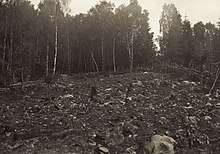
The use of fire in northeastern Sweden changed as agriculture evolved. Although the Sami people did not burn land (since burning killed the lichen required by their reindeer), later farmers frequently used slash-and-burn techniques. The 19th-century Swedish timber industry moved north, clearing the land of trees but leaving waste behind as a fire risk; during the 1870s, fires were frequent.[25] There was a fire in Norrland in 1851, followed by fires in 1868 and 1878; two towns were lost in 1888.[26]
Forest Finns

One culture which flourished in pre-agricultural Europe survives: the Forest Finns in Scandinavia. Martin Tvengsberg, a descendant of the Forest Finns, studied them in his capacity as curator of the Hedmark Museum in Norway.[27] The Savo-Karelians had a sophisticated system for cultivating spruce forests. A runic poem about Finland's spruce forests reads, "Gåivu on mehdien valgoinen valhe" ("The birch is the forest’s white lie"). The best spruce forests reportedly contain birch trees, which grow only after a forest has burned once or twice.
Modern Western world
Slash-and-burn may be defined as the large-scale deforestation of forests for agricultural use. Ashes from the trees help farmers by providing nutrients for the soil.[28]
In industrialized regions, including Europe and North America, the practice was abandoned with the introduction of market agriculture and land ownership. Slash-and-burn agriculture was initially practiced by European pioneers in North America such as Daniel Boone and his family, who cleared land in the Appalachian Mountains during the late 18th and early 19th centuries.[29] However, land cleared by slash-and-burn farmers was eventually taken over by systems of land tenure focusing on long-term improvement and discouraging practices associated with slash-and-burn agriculture.
Northern European heritage
Telkkämäki Nature Reserve in Kaavi, Finland, is an open-air museum which still practices slash-and-burn agriculture. Farm visitors can see how people farmed when slash-and-burn agriculture became the norm in the Northern Savonian region of eastern Finland beginning in the 15th century. Areas of the reserve are burnt each year.[30]
South Asia
Tribal groups in the northeastern Indian states of Tripura, Arunachal Pradesh, Meghalaya, Mizoram and Nagaland and the Bangladeshi districts of Rangamati, Khagrachari, Bandarban and Sylhet refer to slash-and-burn agriculture as jhum or jhoom cultivation. The system involves clearing land, by fire or clear-felling, for economically-important crops such as upland rice, vegetables or fruits. After a few cycles, the land's fertility declines and a new area is chosen. Jhum cultivation is most often practiced on the slopes of thickly-forested hills. Cultivators cut the treetops to allow sunlight to reach the land, burning the trees and grasses for fresh soil. Although it is believed that this helps fertilize the land, it can leave it vulnerable to erosion. Holes are made for the seeds of crops[31] such as sticky rice, maize, eggplant and cucumber are planted. After considering jhum's effects, the government of Mizoram has introduced a policy to end the method in the state.[32] Slash-and-burn is typically a type of subsistence agriculture, not focused on a need to sell crops globally; planting decisions are governed by the needs of the family (or clan) for the coming year.[33]
Gallery
- Modern slash-and-burn practice
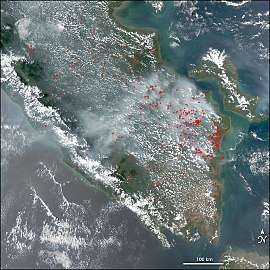
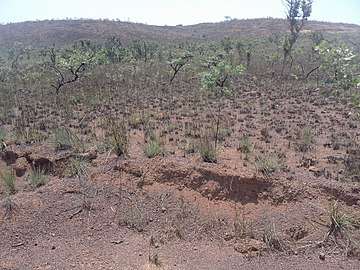
.jpg)
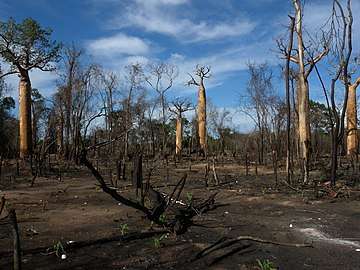
 Isalo National Park, Madagascar
Isalo National Park, Madagascar

See also
References
- "Agricultural burning". The Encyclopedia of World Problems. Archived from the original on 22 November 2018.
- Cornell, Joseph D. (31 January 2007). "Slash and burn". Encyclopedia of Earth.
- "Slash-and-burn agriculture". Encyclopaedia Britannica.
- EcoLogic Development Fund. "Slash and Burn Agriculture". ecologic.org.
- Choudhury, Sanjoy (March–April 2010). "Jhum". Geography and You. Vol. 10 no. 59. Archived from the original on 4 March 2019.
- Disha Experts (2018). 1500+ MCQs with Explanatory Notes For Geography, Ecology & Environment. Disha Publications. p. 130.
- Skegg, Martin (24 September 2011). "TV highlights 27/09/2011". The Guardian. Archived from the original on 10 March 2017.
- Kettler, J. S. (1996-08-01). "Fallow enrichment of a traditional slash/mulch system in southern Costa Rica: comparisons of biomass production and crop yield". Agroforestry Systems. 35 (2): 165–176. doi:10.1007/BF00122777. ISSN 0167-4366.
- Biederman, L. A. (31 December 2012). "Biochar and its effects on plant productivity and nutrient cycling: a meta-analysis". GCB Bioenergy. 5 (2): 202–214. doi:10.1111/gcbb.12037.
- Elkan, Daniel (21 April 2004). "Fired with ambition". The Guardian. Archived from the original on 4 March 2019.
- Jaime Awe, Maya Cities and Sacred Caves, Cu bola Books (2006)
- "Best Management Practices for Wood Ash as Agricultural Soil Amendment" (PDF). athenaeum.libs.uga.edu.
- "Slash and Burn Agriculture | EcoLogic Development Fund". www.ecologic.org. Retrieved 2018-01-10.
- Clark J.G.D. 1952, Farming: Clearance and Cultivation II Prehistoric Europe: The Economic Basis, Cambridge.
- Semple E.C.1931, Ancient Mediterranean Forests and the Lumber Trade, vol. II., p. 261-296. Henry Holt et al., The Geography of the Mediterranean Region, New York.
- Homer, e.g., Iliad XIII.11–13, Odyssey IX.22–24.
- Darby, H.C., 1950, Domesday Woodland II Economic History Review, 2d ser.,III, London; Darby, H.C., 1956, The clearing of the Woodland in Europe II, p 186.
- Perkins and Marvin, Ex Editione Oberliniana, Harvard College Library, 1840 (Xxvi, 15–23).
- Arenander E.O. 1923, Germanemas jordbrukskultur ornkring KristifØdelse // Berattelse over Det Nordiska Arkeologmotet i Stockholm 1922, Stockholm.
- "U.S. Department of Agriculture Lacey Act Guidance". USDA APHIS. October 26, 2011.
- Stewart O.C. 1956, Fire as the First Great Force Employed by Man, II. Thomas W.L. Man's Role in Changing the Face of the Earth, Chicago.
- Zwingle, E. (January 2005), "Italy before the Romans", National Geographic
- Late antique writers commonly used Getae for Goths mixing the peoples in the process.
- G. Costa, 32. Also: De Rebus Geticis: O. Seyffert, 329; De Getarum (Gothorum) Origine et Rebus Gestis: W. Smith, vol 2 page 607
- Alexander, Andrew C. Scott, David M.J.S. Bowman, William J. Bond, Stephen J. Pyne, Martin E. (2013). Fire on Earth : An Introduction. Hoboken: John Wiley & Sons Inc. p. 287. ISBN 978-1118570715.
- Pyne, Stephen J. (1997). World Fire : The Culture of Fire on Earth (Pbk. ed.). Seattle: University of Washington Press. p. 85. ISBN 978-0295975931.
- Svedjebruk.Hedmark 2010.Foreword by Ragnhild Queseth Haarstad Styreleder i Norsk Skogfinsk Museum. ISBN 978-82-93036-00-5.
- "Slash and Burn Agriculture – An Overview of Slash and Burn". Geography.about.com. Retrieved 2013-06-22.
- "Blog Archive » Farmer Power: The Continuing Confrontation between Subsistence Farmers and Development Bureaucrats". Ethnography.com. 2010-12-02. Archived from the original on 2016-05-27. Retrieved 2013-06-22.
- "Telkkämäki Nature Reserve". Outdoors.fi. 2013-05-14. Archived from the original on 2013-07-17. Retrieved 2013-06-22.
- "Jhum". banglapedia.org.
- TI Trade (2011-01-17). "The Assam Tribune Online". Assamtribune.com. Retrieved 2013-06-22.
- Tony Waters, The Persistence of Subsistence Agriculture. Lexington Books (2007), p. 48.
External links
| Look up swidden in Wiktionary, the free dictionary. |
| Wikisource has original text related to this article: |
- Karki, Sameer (2002). "Community Involvement in and Management of Forest Fires in South East Asia" (PDF). Project FireFight South East Asia. Archived (PDF) from the original on 22 October 2018. Cite journal requires
|journal=(help) - Video of slash-and-burn at the Telkkämäki Nature Reserve, Finland, in 2012
- Video of slash-and-burn in Sweden around 1930–32 (from the YouTube channel of the Nordic Museum)

